Back to Page
Amazon Product Listing
How To Drive External Traffic To Amazon Listings
How To Drive External Traffic To Amazon Listings
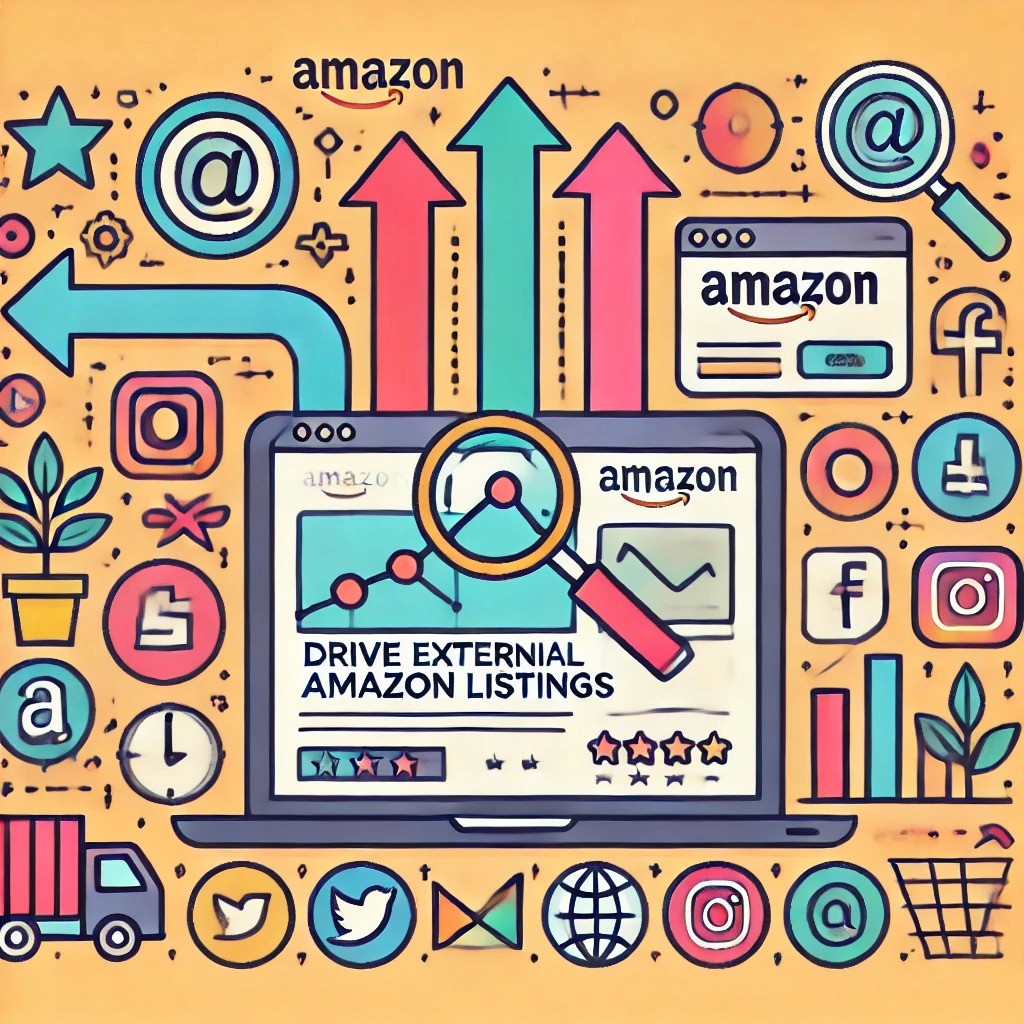

Back to Page
Amazon Product Listing
How To Drive External Traffic To Amazon Listings

Jul 27, 2022
Competition is fierce on Amazon. The uptick in traffic because of the pandemic has caused CPCs (Cost-Per-Click) to soar. It is almost impossible to stand out with organic marketing tactics and costlier to increase visibility via paid advertising.
Brands wanting to speed their growth in the competitive marketplace can top off their internal paid and organic traffic driving efforts with external traffic driving activities.
Reasons why you should drive external traffic to your listing
#1: It’s what Amazon wants
Not-so-surprisingly, Amazon wants sellers to drive traffic from other sources. With the launch of the new Brand Referral Program in 2021, Amazon is giving even more reasons to level up your external traffic. Brands registered in this program can earn a 10% bonus from qualifying sales. To earn a bonus, you must use Amazon Attribution tags to track sales that come from off-Amazon sources.
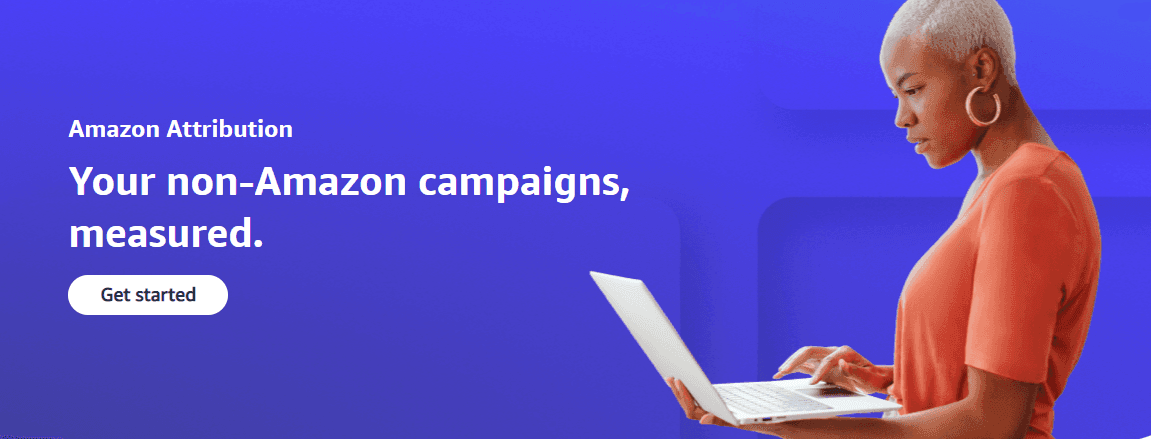
Related post: Brand Referral Bonus - Monetize Your Off Amazon Marketing Efforts
#2 It helps expand your customer base outside the boundaries of Amazon
According to JungleScout, about 74% of US customers begin their product searches on Amazon. While the number is imposing, it’s essential to note that about 26% of the searches still happen off-Amazon.
Utilizing internal paid and organic optimization techniques can help you influence the 74% of shoppers that already shop on Amazon, but off Amazon marketing can help you tap into the big chunk of potential customers and expand your horizons.
#3: It helps you close a sale before the noise kicks in
Optimizing your listing for visibility and conversion, creating A+ Content, building a store, and running paid advertising campaigns are some sure-shot ways to increase sales potential and brand presence on Amazon. The issue, however, is that almost every seller on Amazon is doing it too.
For your product to be memorable, it needs to be seen on its own. Driving off Amazon traffic lets you influence the shopper before competitors steal your thunder.
4: It’s an opportunity to market your product your way
Amazon has restrictions for everything – how you describe your product, photograph your product and present your product. Including common words such as “eco-friendly,” “all-natural,” and “germs” in your listing can land you in great trouble.
When advertising outside of Amazon, you can be as creative as possible. You can craft an exclusive brand voice and turn your ads into a memory that’ll be etched into the shopper’s mind for a long time.
#5: It helps you create your own identity
When you make a sale on Amazon, you haven’t gained a customer; Amazon has. By driving external traffic, you are creating a more sustainable business model.
Rather than depending solely on Amazon for sales, you are paving your way to gain control over the success of your brand. By including off-Amazon strategies in your marketing plan, you aren’t not only maximizing sales but are also securing your brand’s future by creating a customer base that’s only yours.
#6: It helps you to get a leg up on the competition
Being found on Amazon has never been more challenging. Although PPC is an incredibly effective way to drive qualified traffic to your listings, there may be instances when your products need an extra push to be a success. Driving off-Amazon traffic can be the edge you are looking to gain traction and organic rank.
What’s the cost to drive external traffic?

Most non-Amazon traffic sources are paid and it’s not exactly cheap to run off-Amazon campaigns if you’ve just started. The cost of driving external traffic includes running paid ad campaigns, creating creatives that compel distracted shoppers on social media, and Google SERPs to stop scrolling and visit your detail page, the cost, and offering a discount to give shoppers a reason to buy from you.
All the costs incurred in running external traffic generation campaigns can take away your profit without guaranteeing sales.
That’s why brands should consider external traffic generation activities as an investment and run campaigns for products already thriving on Amazon. To maximize profitability, aim to obtain qualified external shoppers more likely to convert. Brands can do this by choosing the right channel based on their target audience.
If you’re too skeptical about trying out new channels, a good strategy would be to try one channel at a time. Create a few campaigns with a specific goal (increasing sales, building brand awareness, collecting emails, etc.). Let the campaign run for at least 10 days and test the results. If the campaign was successful, double down on that channel. If not, try another one.
How to drive external traffic to your listing – proven ways
Any platform that’s not Amazon can be a source to drive external traffic. While you might be tempted to include all of them in your off-Amazon marketing strategy, we’ll focus on tried and tested sources that are proven to be a success.
#1: Leverage Sponsored Display

Launched in 2019, Sponsored Display allows you to target customers off Amazon on sites like Twitch. What helps these ads stand out is that advertisers can target shoppers who have either already seen the listing or showed interest in the product category.
About 25% of Amazon sellers are already leveraging Sponsored Displays. Like any other Sponsored Ads, Sponsored Display ads have no minimal bidding or daily budget restrictions, making them perfect for brands with a thin budget.
#2: Build a solid social media presence

Over the years, social media has evolved. It is not only a place to communicate and share. Brands have been using it as a source to drive awareness and sales on Amazon.
Almost every successful brand on Amazon is resorting to popular social media channels like Facebook, Instagram, TikTok, and Pinterest to connect and engage with a wider audience.
Popular social media channels brands choose to drive external traffic
Facebook: With the ability to target advertising to specific groups of people based on interests, activities, and location, Facebook ads let you advertise in front of the right people at the right time. Video ads work best on Facebook.
Instagram: The image-based nature of the platform makes it ideal for creative marketing through the use of clever visuals and short reels.
YouTube: YouTube videos appear on Google searches, making them highly noticeable. Using influencer-sponsored content, reviews, and unboxing videos, YouTube helps create a lasting impression on shoppers. If this isn’t enough to convince you, keep in mind that about 73% of shoppers watch a video before making a purchase.
TikTok: With over 800 million users, TikTok is the fastest growing social media platform and the #1 downloaded app on Google Play and the App Store. On TikTok, people binge on fun videos that look like their friends made it. Brands can either film themselves or hire an influencer.
Pinterest: Create a Pinterest profile that represents your brand. Once your profile is up and running, start creating boards. Don’t go overboard with promoting your products; instead, be creative with the images and copy you upload. Link each image to your Amazon listing and add a brand logo to your creatives so shoppers can know it’s you.
Best practices for social media advertising
Identify your target audience. For instance, if you are selling beauty products, then young girls and women, in general, are your target audience.
Keep your video ads succinct. Nothing more than 20 seconds (YouTube is an exception).
Be sure to link your Amazon storefront and product detail pages in each ad.
Work with influencers to make your ads impactful.
Use relevant hashtags like #AmazonFinds #OnlineShopping #AmazonHacks to target relevant audiences.
#3: Hire an influencer

Influencers are trusted more than traditional forms of advertisement. What was a $1.7 billion industry in 2016 has grown to $13.8 billion in 2021 with no signs of slowing down. According to Bobsled, a whopping 66% of consumers aged 18-29 have said that they trust an influencer over a traditional commercial. 89% of marketers say that ROI from influencer marketing is comparable to or better than other marketing channels.
When done correctly, influencer marketing campaigns can bring raving sales. Influencers have followers who rely on their word and shoppers are arriving on a dependable website like Amazon, so the campaign is sure to succeed.
#4: Build an email list

A common way to build an email list is by including a packaging insert that asks customers for their email and, in return, offers them an incentive – a free gift, a discount code, etc. Make sure to avoid any information regarding reviews in the insert, or Amazon might suspend your listings or take away selling rights.
After building an email list, brands can use it to announce new product launches, offer exclusive discounts, cross-sell or up-sell, educate customers on how to use the products, etc.
#5: Advertise on Google
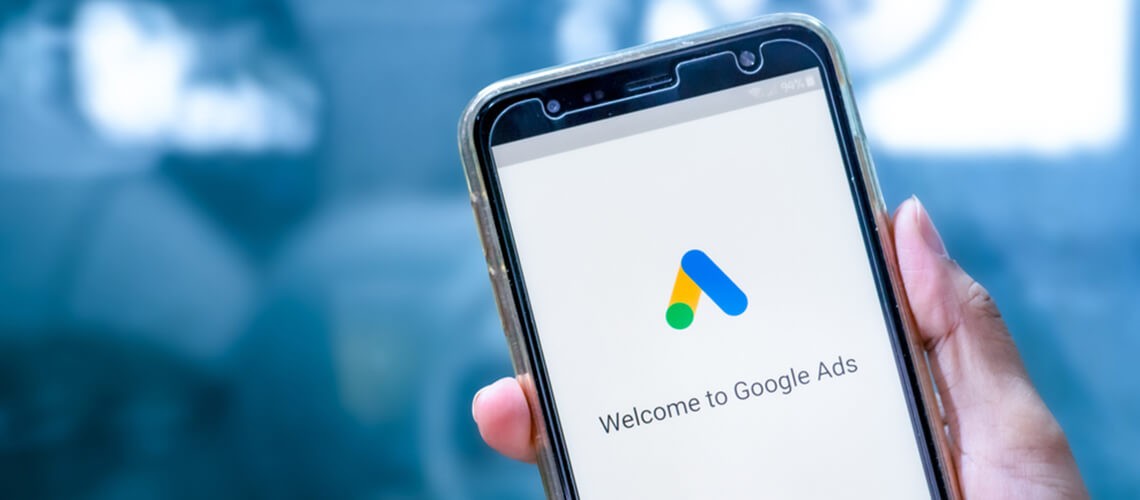
Most product searches might begin on Amazon, but most searches begin on Google. About 25% of Amazon sellers leverage Google Ads to promote their products. Similar to Sponsored Ads, Google Ads text and keyword-based ads are easy to set up and likely to provide a positive ROI. Ask your eCommerce SEO consultant to plan and build campaigns for Google Ads and divert qualified traffic to your listings.
#6: Rope in affiliate bloggers

There are various niche sites run by bloggers who are part of the Amazon Associates Program. Ask them to write about your product and include an affiliate link to your detail page. Bloggers earn a commission every time a visitor clicks on the link and buys the product and brands can get external traffic diverted to their listing.
The simplest way to connect with affiliate bloggers is by running a quick Google search related to your product/niche. If you are selling “foot insoles,” search for “best foot insoles” on Google and you’ll find the first few pages filled with blogs and articles comparing various products. Connect with the blogger and ask them to include your product in the list.
#7: Tap into ready-to-buy audiences with the deals website

Websites like Deal News and Slick Deals have dedicated sections where shoppers discuss new products and give reviews. Brands wanting to increase off-Amazon traffic on your listing can advertise on these websites and target ready-to-buy audiences. The chances of your ads converting are better because you are advertising in front of shoppers with purchase intent.
What NOT to do while driving external traffic to your listing?
#1: Don’t break the rules
You must, at any cost, avoid violation of Amazon’s guidelines and terms of service. Although most of the language in Amazon’s guidelines is vague, the general idea is to avoid driving traffic away from Amazon or seeking ways to artificially obtain positive reviews.
#2: Don’t bring traffic directly to your listings
Another thing to note is that external traffic should never be routed directly to a product listing. Shoppers on Amazon are there with purchase intent, but the external traffic you are bringing might not be. The average conversion rate on Amazon is 9.87%. In comparison, the average landing page conversion rate is just 2.35%.
Sales velocity and conversion rates are some of the most significant contributing factors in determining your organic rank. Because of the increase in listing bounce rate due to external traffic, your ranking can decline.
Instead, create a customized landing page that filters the shoppers before redirecting them to your listing. A landing page not only weeds out low-interest visitors but also helps you build an email list of shoppers who are actually interested in your product.
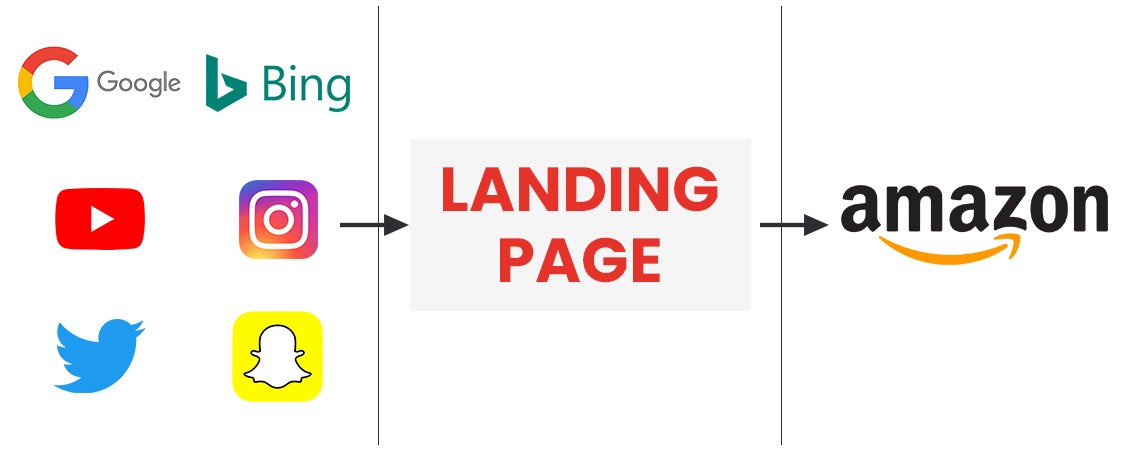
#3: Don’t skimp on Amazon listing optimization
As for any traffic-bringing activity, you must begin with thoroughly optimizing the listing before directing any traffic to your detail page. If your photos aren’t high quality, if your copy doesn’t give all the information a customer needs to make a purchase, if you don’t have an A+ Content in your Product Description section, you might as well not bring any traffic to your listing – external or internal.
Before driving any external traffic to your listing - or any traffic for that matter - make sure it has:
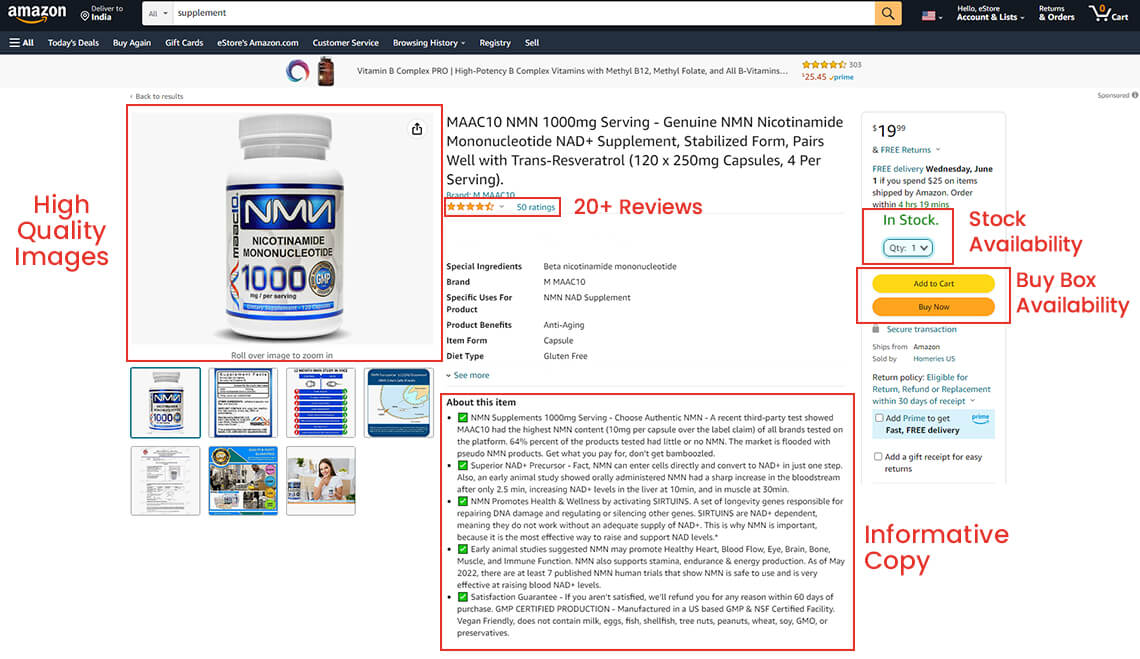
Nine high-quality images, including Amazon-compliant hero images, infographics images, and product-in-use images
Informative copy with five bullets and a description
Amazon A+ Content (Enhanced Brand Content)
20+ reviews with at least a 4-star rating
Buy box eligibility
Stock availability
The best way to ensure that your listing is thoroughly optimized is by hiring an Amazon creative agency.
#4: Don’t advertise newly launched products
Shoppers you will target off-Amazon are not there with purchase intent. They are probably scrolling through the feed while catching up with friends, not necessarily intending to purchase anything.
Advertising products that are already successful on Amazon or products that adorn the best seller badge might pique shoppers’ interest in your products.
You’ll be surprised at the opportunities lying off Amazon
Relying only on Amazon’s traffic can leave a huge chunk of potential shoppers untapped. Whether you’re struggling to thrive in a highly congested category, want to build demand for a new product, or your Amazon sales are great as it is, ramp up your off-Amazon marketing efforts to expand your reach.
Though there is a degree of risk associated with the success of off-Amazon marketing campaigns, having a proper strategy in place is key to being successful.
If you find yourself pressed for time to create a strategy, find the right channel, and optimize campaigns, partner with a professional Amazon management Agency like eStore Factory.
Competition is fierce on Amazon. The uptick in traffic because of the pandemic has caused CPCs (Cost-Per-Click) to soar. It is almost impossible to stand out with organic marketing tactics and costlier to increase visibility via paid advertising.
Brands wanting to speed their growth in the competitive marketplace can top off their internal paid and organic traffic driving efforts with external traffic driving activities.
Reasons why you should drive external traffic to your listing
#1: It’s what Amazon wants
Not-so-surprisingly, Amazon wants sellers to drive traffic from other sources. With the launch of the new Brand Referral Program in 2021, Amazon is giving even more reasons to level up your external traffic. Brands registered in this program can earn a 10% bonus from qualifying sales. To earn a bonus, you must use Amazon Attribution tags to track sales that come from off-Amazon sources.

Related post: Brand Referral Bonus - Monetize Your Off Amazon Marketing Efforts
#2 It helps expand your customer base outside the boundaries of Amazon
According to JungleScout, about 74% of US customers begin their product searches on Amazon. While the number is imposing, it’s essential to note that about 26% of the searches still happen off-Amazon.
Utilizing internal paid and organic optimization techniques can help you influence the 74% of shoppers that already shop on Amazon, but off Amazon marketing can help you tap into the big chunk of potential customers and expand your horizons.
#3: It helps you close a sale before the noise kicks in
Optimizing your listing for visibility and conversion, creating A+ Content, building a store, and running paid advertising campaigns are some sure-shot ways to increase sales potential and brand presence on Amazon. The issue, however, is that almost every seller on Amazon is doing it too.
For your product to be memorable, it needs to be seen on its own. Driving off Amazon traffic lets you influence the shopper before competitors steal your thunder.
4: It’s an opportunity to market your product your way
Amazon has restrictions for everything – how you describe your product, photograph your product and present your product. Including common words such as “eco-friendly,” “all-natural,” and “germs” in your listing can land you in great trouble.
When advertising outside of Amazon, you can be as creative as possible. You can craft an exclusive brand voice and turn your ads into a memory that’ll be etched into the shopper’s mind for a long time.
#5: It helps you create your own identity
When you make a sale on Amazon, you haven’t gained a customer; Amazon has. By driving external traffic, you are creating a more sustainable business model.
Rather than depending solely on Amazon for sales, you are paving your way to gain control over the success of your brand. By including off-Amazon strategies in your marketing plan, you aren’t not only maximizing sales but are also securing your brand’s future by creating a customer base that’s only yours.
#6: It helps you to get a leg up on the competition
Being found on Amazon has never been more challenging. Although PPC is an incredibly effective way to drive qualified traffic to your listings, there may be instances when your products need an extra push to be a success. Driving off-Amazon traffic can be the edge you are looking to gain traction and organic rank.
What’s the cost to drive external traffic?

Most non-Amazon traffic sources are paid and it’s not exactly cheap to run off-Amazon campaigns if you’ve just started. The cost of driving external traffic includes running paid ad campaigns, creating creatives that compel distracted shoppers on social media, and Google SERPs to stop scrolling and visit your detail page, the cost, and offering a discount to give shoppers a reason to buy from you.
All the costs incurred in running external traffic generation campaigns can take away your profit without guaranteeing sales.
That’s why brands should consider external traffic generation activities as an investment and run campaigns for products already thriving on Amazon. To maximize profitability, aim to obtain qualified external shoppers more likely to convert. Brands can do this by choosing the right channel based on their target audience.
If you’re too skeptical about trying out new channels, a good strategy would be to try one channel at a time. Create a few campaigns with a specific goal (increasing sales, building brand awareness, collecting emails, etc.). Let the campaign run for at least 10 days and test the results. If the campaign was successful, double down on that channel. If not, try another one.
How to drive external traffic to your listing – proven ways
Any platform that’s not Amazon can be a source to drive external traffic. While you might be tempted to include all of them in your off-Amazon marketing strategy, we’ll focus on tried and tested sources that are proven to be a success.
#1: Leverage Sponsored Display

Launched in 2019, Sponsored Display allows you to target customers off Amazon on sites like Twitch. What helps these ads stand out is that advertisers can target shoppers who have either already seen the listing or showed interest in the product category.
About 25% of Amazon sellers are already leveraging Sponsored Displays. Like any other Sponsored Ads, Sponsored Display ads have no minimal bidding or daily budget restrictions, making them perfect for brands with a thin budget.
#2: Build a solid social media presence

Over the years, social media has evolved. It is not only a place to communicate and share. Brands have been using it as a source to drive awareness and sales on Amazon.
Almost every successful brand on Amazon is resorting to popular social media channels like Facebook, Instagram, TikTok, and Pinterest to connect and engage with a wider audience.
Popular social media channels brands choose to drive external traffic
Facebook: With the ability to target advertising to specific groups of people based on interests, activities, and location, Facebook ads let you advertise in front of the right people at the right time. Video ads work best on Facebook.
Instagram: The image-based nature of the platform makes it ideal for creative marketing through the use of clever visuals and short reels.
YouTube: YouTube videos appear on Google searches, making them highly noticeable. Using influencer-sponsored content, reviews, and unboxing videos, YouTube helps create a lasting impression on shoppers. If this isn’t enough to convince you, keep in mind that about 73% of shoppers watch a video before making a purchase.
TikTok: With over 800 million users, TikTok is the fastest growing social media platform and the #1 downloaded app on Google Play and the App Store. On TikTok, people binge on fun videos that look like their friends made it. Brands can either film themselves or hire an influencer.
Pinterest: Create a Pinterest profile that represents your brand. Once your profile is up and running, start creating boards. Don’t go overboard with promoting your products; instead, be creative with the images and copy you upload. Link each image to your Amazon listing and add a brand logo to your creatives so shoppers can know it’s you.
Best practices for social media advertising
Identify your target audience. For instance, if you are selling beauty products, then young girls and women, in general, are your target audience.
Keep your video ads succinct. Nothing more than 20 seconds (YouTube is an exception).
Be sure to link your Amazon storefront and product detail pages in each ad.
Work with influencers to make your ads impactful.
Use relevant hashtags like #AmazonFinds #OnlineShopping #AmazonHacks to target relevant audiences.
#3: Hire an influencer

Influencers are trusted more than traditional forms of advertisement. What was a $1.7 billion industry in 2016 has grown to $13.8 billion in 2021 with no signs of slowing down. According to Bobsled, a whopping 66% of consumers aged 18-29 have said that they trust an influencer over a traditional commercial. 89% of marketers say that ROI from influencer marketing is comparable to or better than other marketing channels.
When done correctly, influencer marketing campaigns can bring raving sales. Influencers have followers who rely on their word and shoppers are arriving on a dependable website like Amazon, so the campaign is sure to succeed.
#4: Build an email list

A common way to build an email list is by including a packaging insert that asks customers for their email and, in return, offers them an incentive – a free gift, a discount code, etc. Make sure to avoid any information regarding reviews in the insert, or Amazon might suspend your listings or take away selling rights.
After building an email list, brands can use it to announce new product launches, offer exclusive discounts, cross-sell or up-sell, educate customers on how to use the products, etc.
#5: Advertise on Google

Most product searches might begin on Amazon, but most searches begin on Google. About 25% of Amazon sellers leverage Google Ads to promote their products. Similar to Sponsored Ads, Google Ads text and keyword-based ads are easy to set up and likely to provide a positive ROI. Ask your eCommerce SEO consultant to plan and build campaigns for Google Ads and divert qualified traffic to your listings.
#6: Rope in affiliate bloggers

There are various niche sites run by bloggers who are part of the Amazon Associates Program. Ask them to write about your product and include an affiliate link to your detail page. Bloggers earn a commission every time a visitor clicks on the link and buys the product and brands can get external traffic diverted to their listing.
The simplest way to connect with affiliate bloggers is by running a quick Google search related to your product/niche. If you are selling “foot insoles,” search for “best foot insoles” on Google and you’ll find the first few pages filled with blogs and articles comparing various products. Connect with the blogger and ask them to include your product in the list.
#7: Tap into ready-to-buy audiences with the deals website

Websites like Deal News and Slick Deals have dedicated sections where shoppers discuss new products and give reviews. Brands wanting to increase off-Amazon traffic on your listing can advertise on these websites and target ready-to-buy audiences. The chances of your ads converting are better because you are advertising in front of shoppers with purchase intent.
What NOT to do while driving external traffic to your listing?
#1: Don’t break the rules
You must, at any cost, avoid violation of Amazon’s guidelines and terms of service. Although most of the language in Amazon’s guidelines is vague, the general idea is to avoid driving traffic away from Amazon or seeking ways to artificially obtain positive reviews.
#2: Don’t bring traffic directly to your listings
Another thing to note is that external traffic should never be routed directly to a product listing. Shoppers on Amazon are there with purchase intent, but the external traffic you are bringing might not be. The average conversion rate on Amazon is 9.87%. In comparison, the average landing page conversion rate is just 2.35%.
Sales velocity and conversion rates are some of the most significant contributing factors in determining your organic rank. Because of the increase in listing bounce rate due to external traffic, your ranking can decline.
Instead, create a customized landing page that filters the shoppers before redirecting them to your listing. A landing page not only weeds out low-interest visitors but also helps you build an email list of shoppers who are actually interested in your product.

#3: Don’t skimp on Amazon listing optimization
As for any traffic-bringing activity, you must begin with thoroughly optimizing the listing before directing any traffic to your detail page. If your photos aren’t high quality, if your copy doesn’t give all the information a customer needs to make a purchase, if you don’t have an A+ Content in your Product Description section, you might as well not bring any traffic to your listing – external or internal.
Before driving any external traffic to your listing - or any traffic for that matter - make sure it has:

Nine high-quality images, including Amazon-compliant hero images, infographics images, and product-in-use images
Informative copy with five bullets and a description
Amazon A+ Content (Enhanced Brand Content)
20+ reviews with at least a 4-star rating
Buy box eligibility
Stock availability
The best way to ensure that your listing is thoroughly optimized is by hiring an Amazon creative agency.
#4: Don’t advertise newly launched products
Shoppers you will target off-Amazon are not there with purchase intent. They are probably scrolling through the feed while catching up with friends, not necessarily intending to purchase anything.
Advertising products that are already successful on Amazon or products that adorn the best seller badge might pique shoppers’ interest in your products.
You’ll be surprised at the opportunities lying off Amazon
Relying only on Amazon’s traffic can leave a huge chunk of potential shoppers untapped. Whether you’re struggling to thrive in a highly congested category, want to build demand for a new product, or your Amazon sales are great as it is, ramp up your off-Amazon marketing efforts to expand your reach.
Though there is a degree of risk associated with the success of off-Amazon marketing campaigns, having a proper strategy in place is key to being successful.
If you find yourself pressed for time to create a strategy, find the right channel, and optimize campaigns, partner with a professional Amazon management Agency like eStore Factory.
Competition is fierce on Amazon. The uptick in traffic because of the pandemic has caused CPCs (Cost-Per-Click) to soar. It is almost impossible to stand out with organic marketing tactics and costlier to increase visibility via paid advertising.
Brands wanting to speed their growth in the competitive marketplace can top off their internal paid and organic traffic driving efforts with external traffic driving activities.
Reasons why you should drive external traffic to your listing
#1: It’s what Amazon wants
Not-so-surprisingly, Amazon wants sellers to drive traffic from other sources. With the launch of the new Brand Referral Program in 2021, Amazon is giving even more reasons to level up your external traffic. Brands registered in this program can earn a 10% bonus from qualifying sales. To earn a bonus, you must use Amazon Attribution tags to track sales that come from off-Amazon sources.

Related post: Brand Referral Bonus - Monetize Your Off Amazon Marketing Efforts
#2 It helps expand your customer base outside the boundaries of Amazon
According to JungleScout, about 74% of US customers begin their product searches on Amazon. While the number is imposing, it’s essential to note that about 26% of the searches still happen off-Amazon.
Utilizing internal paid and organic optimization techniques can help you influence the 74% of shoppers that already shop on Amazon, but off Amazon marketing can help you tap into the big chunk of potential customers and expand your horizons.
#3: It helps you close a sale before the noise kicks in
Optimizing your listing for visibility and conversion, creating A+ Content, building a store, and running paid advertising campaigns are some sure-shot ways to increase sales potential and brand presence on Amazon. The issue, however, is that almost every seller on Amazon is doing it too.
For your product to be memorable, it needs to be seen on its own. Driving off Amazon traffic lets you influence the shopper before competitors steal your thunder.
4: It’s an opportunity to market your product your way
Amazon has restrictions for everything – how you describe your product, photograph your product and present your product. Including common words such as “eco-friendly,” “all-natural,” and “germs” in your listing can land you in great trouble.
When advertising outside of Amazon, you can be as creative as possible. You can craft an exclusive brand voice and turn your ads into a memory that’ll be etched into the shopper’s mind for a long time.
#5: It helps you create your own identity
When you make a sale on Amazon, you haven’t gained a customer; Amazon has. By driving external traffic, you are creating a more sustainable business model.
Rather than depending solely on Amazon for sales, you are paving your way to gain control over the success of your brand. By including off-Amazon strategies in your marketing plan, you aren’t not only maximizing sales but are also securing your brand’s future by creating a customer base that’s only yours.
#6: It helps you to get a leg up on the competition
Being found on Amazon has never been more challenging. Although PPC is an incredibly effective way to drive qualified traffic to your listings, there may be instances when your products need an extra push to be a success. Driving off-Amazon traffic can be the edge you are looking to gain traction and organic rank.
What’s the cost to drive external traffic?

Most non-Amazon traffic sources are paid and it’s not exactly cheap to run off-Amazon campaigns if you’ve just started. The cost of driving external traffic includes running paid ad campaigns, creating creatives that compel distracted shoppers on social media, and Google SERPs to stop scrolling and visit your detail page, the cost, and offering a discount to give shoppers a reason to buy from you.
All the costs incurred in running external traffic generation campaigns can take away your profit without guaranteeing sales.
That’s why brands should consider external traffic generation activities as an investment and run campaigns for products already thriving on Amazon. To maximize profitability, aim to obtain qualified external shoppers more likely to convert. Brands can do this by choosing the right channel based on their target audience.
If you’re too skeptical about trying out new channels, a good strategy would be to try one channel at a time. Create a few campaigns with a specific goal (increasing sales, building brand awareness, collecting emails, etc.). Let the campaign run for at least 10 days and test the results. If the campaign was successful, double down on that channel. If not, try another one.
How to drive external traffic to your listing – proven ways
Any platform that’s not Amazon can be a source to drive external traffic. While you might be tempted to include all of them in your off-Amazon marketing strategy, we’ll focus on tried and tested sources that are proven to be a success.
#1: Leverage Sponsored Display

Launched in 2019, Sponsored Display allows you to target customers off Amazon on sites like Twitch. What helps these ads stand out is that advertisers can target shoppers who have either already seen the listing or showed interest in the product category.
About 25% of Amazon sellers are already leveraging Sponsored Displays. Like any other Sponsored Ads, Sponsored Display ads have no minimal bidding or daily budget restrictions, making them perfect for brands with a thin budget.
#2: Build a solid social media presence

Over the years, social media has evolved. It is not only a place to communicate and share. Brands have been using it as a source to drive awareness and sales on Amazon.
Almost every successful brand on Amazon is resorting to popular social media channels like Facebook, Instagram, TikTok, and Pinterest to connect and engage with a wider audience.
Popular social media channels brands choose to drive external traffic
Facebook: With the ability to target advertising to specific groups of people based on interests, activities, and location, Facebook ads let you advertise in front of the right people at the right time. Video ads work best on Facebook.
Instagram: The image-based nature of the platform makes it ideal for creative marketing through the use of clever visuals and short reels.
YouTube: YouTube videos appear on Google searches, making them highly noticeable. Using influencer-sponsored content, reviews, and unboxing videos, YouTube helps create a lasting impression on shoppers. If this isn’t enough to convince you, keep in mind that about 73% of shoppers watch a video before making a purchase.
TikTok: With over 800 million users, TikTok is the fastest growing social media platform and the #1 downloaded app on Google Play and the App Store. On TikTok, people binge on fun videos that look like their friends made it. Brands can either film themselves or hire an influencer.
Pinterest: Create a Pinterest profile that represents your brand. Once your profile is up and running, start creating boards. Don’t go overboard with promoting your products; instead, be creative with the images and copy you upload. Link each image to your Amazon listing and add a brand logo to your creatives so shoppers can know it’s you.
Best practices for social media advertising
Identify your target audience. For instance, if you are selling beauty products, then young girls and women, in general, are your target audience.
Keep your video ads succinct. Nothing more than 20 seconds (YouTube is an exception).
Be sure to link your Amazon storefront and product detail pages in each ad.
Work with influencers to make your ads impactful.
Use relevant hashtags like #AmazonFinds #OnlineShopping #AmazonHacks to target relevant audiences.
#3: Hire an influencer

Influencers are trusted more than traditional forms of advertisement. What was a $1.7 billion industry in 2016 has grown to $13.8 billion in 2021 with no signs of slowing down. According to Bobsled, a whopping 66% of consumers aged 18-29 have said that they trust an influencer over a traditional commercial. 89% of marketers say that ROI from influencer marketing is comparable to or better than other marketing channels.
When done correctly, influencer marketing campaigns can bring raving sales. Influencers have followers who rely on their word and shoppers are arriving on a dependable website like Amazon, so the campaign is sure to succeed.
#4: Build an email list

A common way to build an email list is by including a packaging insert that asks customers for their email and, in return, offers them an incentive – a free gift, a discount code, etc. Make sure to avoid any information regarding reviews in the insert, or Amazon might suspend your listings or take away selling rights.
After building an email list, brands can use it to announce new product launches, offer exclusive discounts, cross-sell or up-sell, educate customers on how to use the products, etc.
#5: Advertise on Google

Most product searches might begin on Amazon, but most searches begin on Google. About 25% of Amazon sellers leverage Google Ads to promote their products. Similar to Sponsored Ads, Google Ads text and keyword-based ads are easy to set up and likely to provide a positive ROI. Ask your eCommerce SEO consultant to plan and build campaigns for Google Ads and divert qualified traffic to your listings.
#6: Rope in affiliate bloggers

There are various niche sites run by bloggers who are part of the Amazon Associates Program. Ask them to write about your product and include an affiliate link to your detail page. Bloggers earn a commission every time a visitor clicks on the link and buys the product and brands can get external traffic diverted to their listing.
The simplest way to connect with affiliate bloggers is by running a quick Google search related to your product/niche. If you are selling “foot insoles,” search for “best foot insoles” on Google and you’ll find the first few pages filled with blogs and articles comparing various products. Connect with the blogger and ask them to include your product in the list.
#7: Tap into ready-to-buy audiences with the deals website

Websites like Deal News and Slick Deals have dedicated sections where shoppers discuss new products and give reviews. Brands wanting to increase off-Amazon traffic on your listing can advertise on these websites and target ready-to-buy audiences. The chances of your ads converting are better because you are advertising in front of shoppers with purchase intent.
What NOT to do while driving external traffic to your listing?
#1: Don’t break the rules
You must, at any cost, avoid violation of Amazon’s guidelines and terms of service. Although most of the language in Amazon’s guidelines is vague, the general idea is to avoid driving traffic away from Amazon or seeking ways to artificially obtain positive reviews.
#2: Don’t bring traffic directly to your listings
Another thing to note is that external traffic should never be routed directly to a product listing. Shoppers on Amazon are there with purchase intent, but the external traffic you are bringing might not be. The average conversion rate on Amazon is 9.87%. In comparison, the average landing page conversion rate is just 2.35%.
Sales velocity and conversion rates are some of the most significant contributing factors in determining your organic rank. Because of the increase in listing bounce rate due to external traffic, your ranking can decline.
Instead, create a customized landing page that filters the shoppers before redirecting them to your listing. A landing page not only weeds out low-interest visitors but also helps you build an email list of shoppers who are actually interested in your product.

#3: Don’t skimp on Amazon listing optimization
As for any traffic-bringing activity, you must begin with thoroughly optimizing the listing before directing any traffic to your detail page. If your photos aren’t high quality, if your copy doesn’t give all the information a customer needs to make a purchase, if you don’t have an A+ Content in your Product Description section, you might as well not bring any traffic to your listing – external or internal.
Before driving any external traffic to your listing - or any traffic for that matter - make sure it has:

Nine high-quality images, including Amazon-compliant hero images, infographics images, and product-in-use images
Informative copy with five bullets and a description
Amazon A+ Content (Enhanced Brand Content)
20+ reviews with at least a 4-star rating
Buy box eligibility
Stock availability
The best way to ensure that your listing is thoroughly optimized is by hiring an Amazon creative agency.
#4: Don’t advertise newly launched products
Shoppers you will target off-Amazon are not there with purchase intent. They are probably scrolling through the feed while catching up with friends, not necessarily intending to purchase anything.
Advertising products that are already successful on Amazon or products that adorn the best seller badge might pique shoppers’ interest in your products.
You’ll be surprised at the opportunities lying off Amazon
Relying only on Amazon’s traffic can leave a huge chunk of potential shoppers untapped. Whether you’re struggling to thrive in a highly congested category, want to build demand for a new product, or your Amazon sales are great as it is, ramp up your off-Amazon marketing efforts to expand your reach.
Though there is a degree of risk associated with the success of off-Amazon marketing campaigns, having a proper strategy in place is key to being successful.
If you find yourself pressed for time to create a strategy, find the right channel, and optimize campaigns, partner with a professional Amazon management Agency like eStore Factory.









